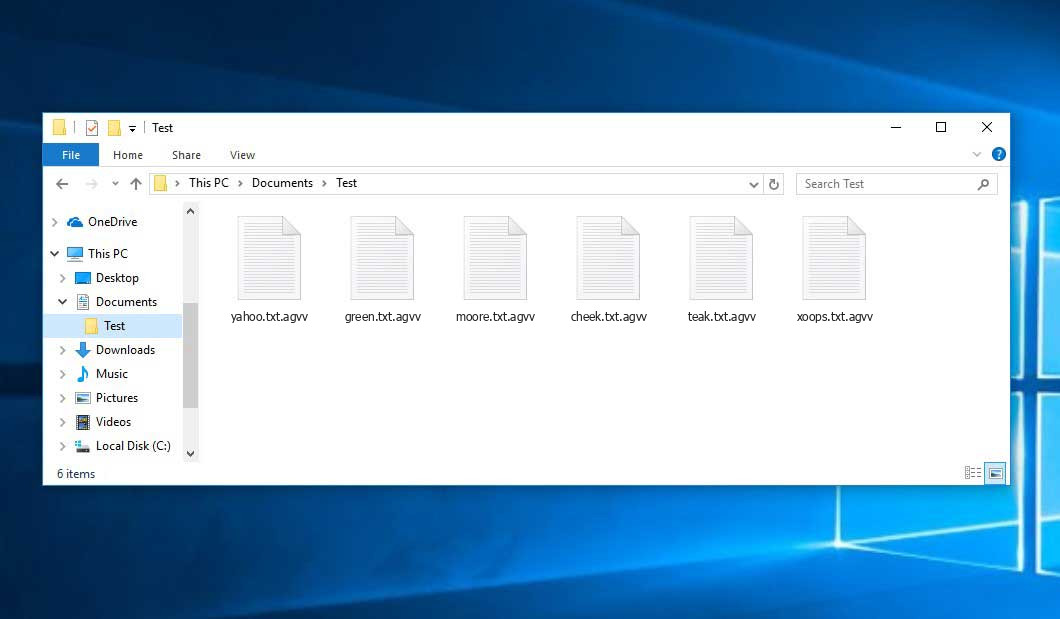I have discovered the presence of AGVV ransomware, which belongs to the STOP/Djvu ransomware family. An analysis of samples submitted to VirusTotal1.
Once a computer gets infected with AGVV virus, it takes immediate action by encrypting files and appending the “.agvv” extension to their original filenames. For instance, a file named “a.jpg” would be renamed as “a.jpg.agvv“, and “b.doc” would be transformed into “b.doc.agvv“.
The Agvv key is unique for every victim, with an other exception:
- If Agvv cannot establish a connection with the command and control server (C&C Server) prior to beginning the encryption process, it will use the offline key. This key is the same to all the victims which makes it feasible to decrypt encrypted files during a ransomware attack.
I’ve put together a complete listing of all the possible solutions, tricks and practices in neutralizing the Agvv virus, and encryption of files. In some cases it’s easy to recover your files. In other cases, it’s impossible.
Understanding the Agvv Virus
The Agvv virus is a type of ransomware that operates by encrypting files on a victim’s computer and demanding a ransom payment in exchange for the decryption key. It often infiltrates systems through torrents and other illicit software downloads, catching users off guard and leaving them with encrypted files that are inaccessible.
Fortunately, there are methods available to decrypt files without having to pay the ransom. This article aims to provide valuable insights into the Agvv ransomware, along with several techniques for decrypting the encrypted files. Whether you have been affected by the Agvv virus or are interested in strengthening your knowledge of preventing ransomware attacks, continue reading to gain a comprehensive understanding.
The image below provides a visual representation of files encrypted by the Agvv virus, as they appear with the “.agvv” extension:
| Name | Agvv Virus |
| Ransomware family2 | DJVU/STOP3 ransomware |
| Extension | .agvv |
| Ransomware note | _readme.txt |
| Ransom | From $490 to $980 (in Bitcoins) |
| Contact | [email protected], [email protected] |
| Detection | Win32.Virlock.Gen.4, NSIS/Injector.MK, Generic.Trojan.Malicious.DDS |
| Symptoms |
|
| Fix Tool | To remove possible malware infections, scan your PC: 6-day free trial available. |
This message asking payment is for get files back via decryption key:
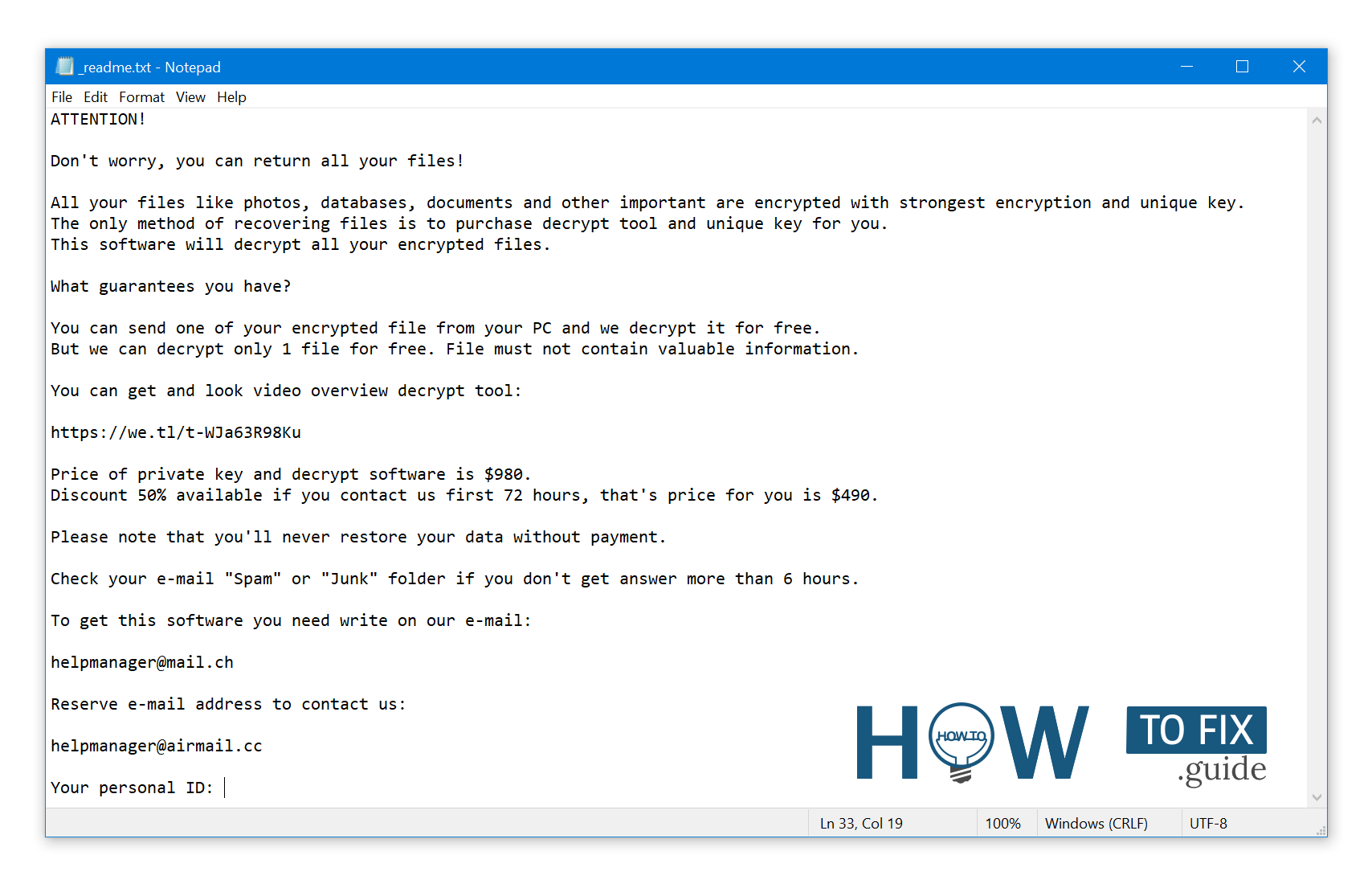
_readme.txt (STOP/DJVU Ransomware) – The scary alert demanding from users to pay the ransom to decrypt the encoded files contains these frustrating warnings
Examining the Ransom Note
The ransom note explicitly instructs victims to initiate contact with the threat actors within a 72-hour window, highlighting the importance of swift communication. Failing to comply with this time frame will result in an increased payment amount of $980, covering the costs associated with the decryption software and key. Initially, the ransom demand stands at $490.
The ransom note emphasizes that the essential tools for file decryption are exclusively in the possession of the threat actors. Without access to these tools, the decryption process becomes unattainable. Furthermore, the “_readme.txt” file provides an option for victims to submit a single encrypted file for decryption, free of charge. To establish communication with the attackers, victims are presented with two email addresses: [email protected] and [email protected].
More About Agvv Ransomware
Restoring files affected by ransomware poses significant challenges without the involvement of the cybercriminals responsible for the attack. Victims have limited options available to restore their files without resorting to paying a ransom. These options include relying on data backups or searching for third-party decryption tools online.
Agvv ransomware operates through a series of processes designed to perform various tasks on the victim’s computer. One of the initial processes launched is winupdate.exe, which presents a deceptive Windows update prompt during the attack. This deceptive prompt aims to convince the victim that a sudden system slowdown is caused by a legitimate Windows update. Simultaneously, the ransomware initiates another process, usually named with four random characters, to scan the system for target files and encrypt them. Additionally, the ransomware utilizes the following CMD command to delete Volume Shadow Copies from the system:
vssadmin.exe Delete Shadows /All /Quiet
Once the Volume Shadow Copies are deleted, the ability to restore the computer to its previous state using System Restore Points becomes impossible. Ransomware operators actively eliminate Windows OS-based methods that could potentially assist victims in restoring files without cost. Moreover, the criminals modify the Windows HOSTS file by adding a list of domains and mapping them to the localhost IP. Consequently, when attempting to access one of the blocked websites, the victim encounters a DNS_PROBE_FINISHED_NXDOMAIN error.
Notably, the ransomware deliberately blocks websites that provide various how-to guides for computer users. This intentional restriction of specific domains aims to prevent victims from accessing relevant and helpful information regarding ransomware attacks online. The virus also saves two text files on the victim’s computer, containing attack-related details: the victim’s public encryption key and personal ID. These files are named bowsakkdestx.txt and PersonalID.txt.
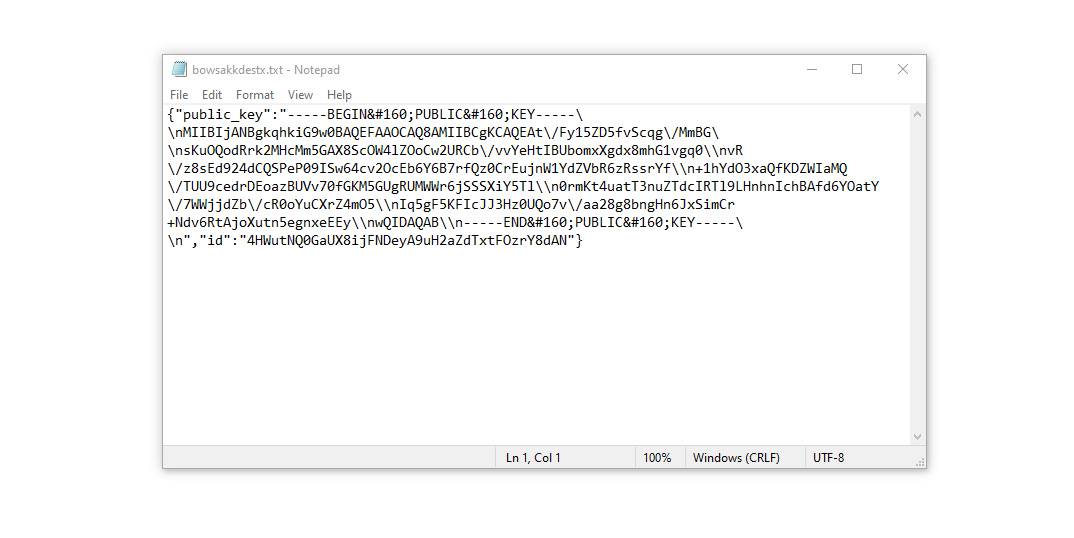
Even after these modifications, the malware remains active. Variants of the STOP/DJVU ransomware often deploy the Vidar password-stealing Trojan on compromised systems. This threat possesses an extensive range of capabilities, including:
- Stealing login credentials for Steam, Telegram, Skype;
- Stealing cryptocurrency wallets;
- Downloading and executing malware on the victim’s computer;
- Collecting browser cookies, saved passwords, and browsing history;
- Viewing and manipulating files on the victim’s computer;
- Enabling remote control and facilitating additional tasks on the victim’s computer.
The DJVU/STOP ransomware family employs the AES-256 encryption algorithm. If your data has been encrypted with a unique online decryption key, it is impossible to decrypt the files without that specific key.
In the event that Agvv operates in online mode, gaining access to the AES-256 key is unattainable. The key is stored on a remote server controlled by the criminals behind the Agvv virus.
To receive the decryption key, the ransom demand stands at $980. The victims are encouraged by the message to contact the fraudsters via email ([email protected]).
The message by the ransomware states the following information:
ATTENTION! Don't worry, you can return all your files! All your files like photos, databases, documents and other important are encrypted with strongest encryption and unique key. The only method of recovering files is to purchase decrypt tool and unique key for you. This software will decrypt all your encrypted files. What guarantees you have? You can send one of your encrypted file from your PC and we decrypt it for free. But we can decrypt only 1 file for free. File must not contain valuable information. You can get and look video overview decrypt tool: https://we.tl/t-WJa63R98Ku Price of private key and decrypt software is $980. Discount 50% available if you contact us first 72 hours, that's price for you is $490. Please note that you'll never restore your data without payment. Check your e-mail "Spam" or "Junk" folder if you don't get answer more than 6 hours. To get this software you need write on our e-mail: [email protected] Reserve e-mail address to contact us: [email protected] Your personal ID: XXXXXXXXXXXXXXXXXXXXXXXXXXXXXXX
How I was infected?
Ransomware has a various methods to built into your system. But it doesn’t really matter what method had place in your case.

Agvv virus attack following a successful phishing attempt.
However, AGVV ransomware can infiltrate your PC through common methods:
- The installation of other apps, especially utilities offered as freeware or shareware, may hide the ransomware.
- Suspicious links in spam emails can lead you to the virus installer.
- Online free hosting resources can also be a source of infection.
- Downloading pirated software from illegal peer-to-peer (P2P) resources can expose you to AGVV ransomware.
Sometimes, the Agvv virus disguises itself as a legitimate tool, often appearing in messages that demand unwanted software or browser updates. Online fraudsters commonly use this tactic to trick you into manually installing the Agvv ransomware, making you an unwitting participant.
These bogus update alerts won’t explicitly mention the virus installation. Instead, they will appear as prompts to update Adobe Flash Player or other questionable programs.
Using cracked apps is also risky, as it is illegal and can lead to the injection of serious malware, including the Agvv ransomware.
To summarize, what can you do to prevent the injection of Agvv ransomware on your device? Although there is no foolproof method, here are some tips to help you minimize the risk:
1. Exercise caution when installing free software and carefully review the additional offers presented during installation.
2. Avoid opening suspicious email attachments or files from unknown senders.
3. Keep your security program up to date at all times.
The malware operates discreetly and does not appear among your available programs. Instead, it runs as a hidden malicious process in the background from the moment you start your PC.
How To Remove Agvv Virus?
In addition to encode a victim’s files, the Agvv virus has also started to install the Vidar Stealer on PC to steal account credentials, cryptocurrency wallets, desktop files, and more.
Reasons why I would recommend GridinSoft4
There is no better way to recognize, remove and prevent ransomware than to use an anti-malware software from GridinSoft.
Download Removal Tool.
You can download GridinSoft Anti-Malware by clicking the button below:
Run the setup file.
When setup file has finished downloading, double-click on the setup-antimalware-fix.exe file to install GridinSoft Anti-Malware on your computer.

An User Account Control asking you about to allow GridinSoft Anti-Malware to make changes to your device. So, you should click “Yes” to continue with the installation.

Press “Install” button.

Once installed, Anti-Malware will automatically run.

Wait for complete.
GridinSoft Anti-Malware will automatically start scanning your PC for Agvv infections and other malicious programs. This process can take a 20-30 minutes, so I suggest you periodically check on the status of the scan process.

Click on “Clean Now”.
When the scan has completed, you will see the list of infections that GridinSoft Anti-Malware has detected. To remove them click on the “Clean Now” button in right corner.

Trojan Killer for special instances
In some certain instances, Agvv ransomware can block the running of setup files of different anti-malware programs. In this situation, you need to utilize the removable drive with a pre-installed antivirus tool.
There is a really little number of security tools that are able to be set up on the USB drives, and antiviruses that can do so in most cases require to obtain quite an expensive license. For this instance, I can recommend you to use another solution of GridinSoft – Trojan Killer Portable. It has a 14-days cost-free trial mode that offers the entire features of the paid version 5. This term will definitely be 100% enough to wipe malware out.
How To Decrypt .agvv Files?
Restore solution for big “.agvv files“
Try removing .agvv extension on a few BIG files and opening them. Either the Agvv infection read and did not encrypt the file, or it bugged and did not add the filemarker. If your files are very large (2GB+), the latter is most likely. Please, let me know in comments if that will work for you.
The newest extensions released around the end of August 2019 after the criminals made changes. As a result of the changes made by the criminals, STOPDecrypter is no longer supported. It has been removed and replaced with the Emsisoft Decryptor for STOP Djvu Ransomware developed by Emsisoft.
You can download free decryption tool here: Decryptor for STOP Djvu.
Download and run decryption tool.
Start downloading the decryption tool.
Make sure to launch the decryption utility as an administrator. You need to agree with the license terms that will come up. For this purpose, click on the “Yes” button:

As soon as you accept the license terms, the main decryptor user interface comes up:

Select folders for decryption.
Based on the default settings, the decryptor will automatically populate the available locations in order to decrypt the currently available drives (the connected ones), including the network drives. Extra (optional) locations can be selected with the help of the “Add” button.
Decryptors normally suggest several options considering the specific malware family. The current possible options are presented in the Options tab and can be activated or deactivated there. You may locate a detailed list of the currently active Options below.
Click on the “Decrypt” button.
As soon as you add all the desired locations for decryption into the list, click on the “Decrypt” button in order to initiate the decryption procedure.
Note that the main screen may turn you to a status view, letting you know of the active process and the decryption statistics of your data:

The decryptor will notify you as soon as the decryption procedure is completed. If you need the report for your personal papers, you can save it by choosing the “Save log” button. Note that it is also possible to copy it directly to your clipboard and to paste it into emails or messages here if you need to do so.
The Emsisoft Decryptor might display different messages after a failed attempt to restore your agvv files:
✓ Error: Unable to decrypt file with ID: [your ID]
✓ No key for New Variant online ID: [your ID]
Notice: this ID appears to be an online ID, decryption is impossible
✓ Result: No key for new variant offline ID: [example ID]
This ID appears be an offline ID. Decryption may be possible in the future.
It can take a few weeks or months until the decryption key gets found and uploaded to the decryptor. Please follow updates regarding the decryptable DJVU versions here.
✓ Remote name could not be resolved
How to Restore .agvv Files?
In some case DJVU ransomware is not doom for your files…
Agvv ransomware encryption mechanism feature is next: it encrypts every file byte-by-byte, then saves a file copy, deleting (and not overriding!) the original file. Hence, the information of the file location on the physical disk is lost, but the original file is not deleted from the physical disk. The cell, or the sector where this file was stored, can still contain this file, but it is not listed by the file system and can be overwritten by data that has been loaded to this disk after the deletion. Hence, it is possible to recover your files using special software.
Anyway, after realizing it was an online algorithm, it is impossible to retrieve my encrypted files. I also had my backup drive plugged in at the time of the virus, and this was also infected, or so I thought. Every folder within my backup drive had been infected and was encrypted. However, despite losing some important files, I retrieved almost 80% of my 2TB storage.
When I started going through the folders, I noticed the readme.txt ransom note in every folder. I opened some of the folders and found that all files that were not in a subfolder within that folder had been encrypted. However, I found a flaw and glimmer of hope when I went into the subfolders in other folders and found that these files had not been encrypted. Every folder within my c and d drives, including subfolders, had been encrypted, but this was not the case with the backup drive. Having subfolders created within a folder has saved 80% of my data.
As I said, I believe this to be only a small loophole on a backup drive. I’ve since found a further 10 % of my data on another hard drive on a different pc. So my advice is if you use a backup drive, create subfolders. I was lucky, I guess. But I was also unlucky that the virus hit as I was transferring some files from my backup.
Hopefully, this can help some other people in my situation.
Jamie NewlandRecovering your files with PhotoRec
PhotoRec is an open-source program, which is originally created for files recovery from damaged disks, or for files recovery in case if they are deleted. However, as time has gone by, this program got the ability to recover the files of 400 different extensions. Hence, it can be used for data recovery after the ransomware attack
At first, you need to download this app. It is 100% free, but the developer states that there is no guarantee that your files will be recovered. PhotoRec is distributed in a pack with other utility of the same developer – TestDisk. The downloaded archive will have TestDisk name, but don’t worry. PhotoRec files are right inside.
To open PhotoRec, you need to find and open “qphotorec_win.exe” file. No installation is required – this program has all the files it need inside of the archive, hence, you can fit it on your USB drive, and try to help your friend/parents/anyone who was been attacked by DJVU/STOP ransomware.
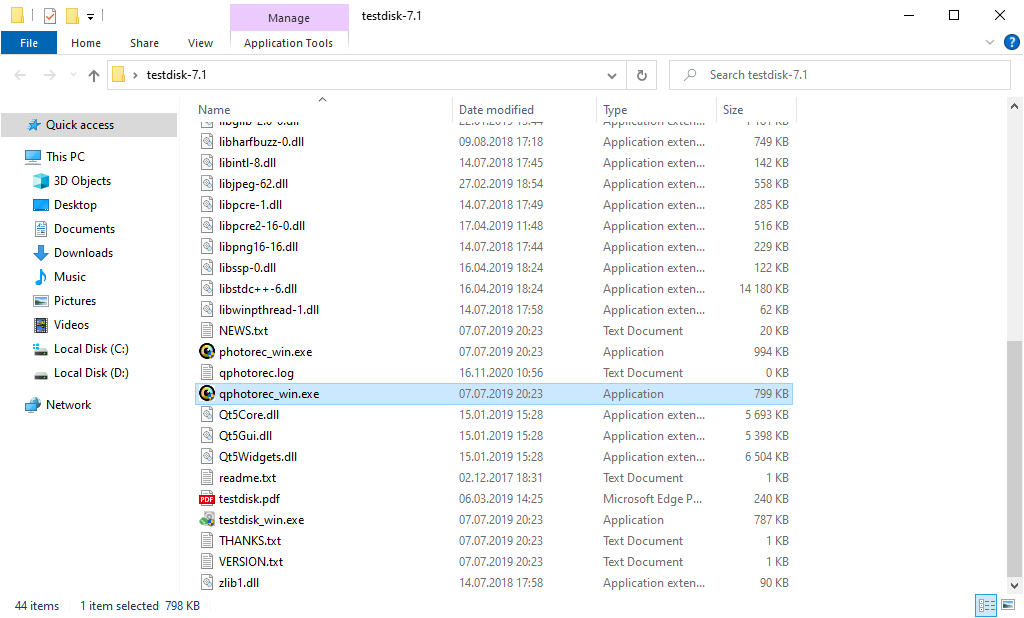
After the launch, you will see the screen showing you the full list of your disk spaces. However, this information is likely useless, because the required menu is placed a bit higher. Click this bar, then choose the disk which was attacked by ransomware.
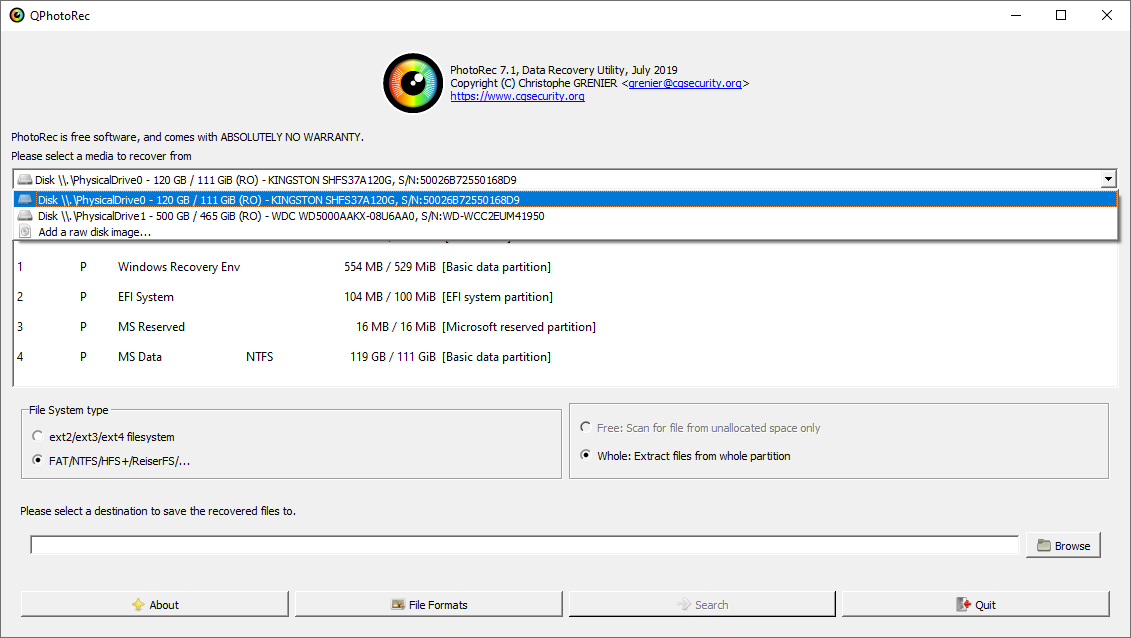
After choosing the disk, you need to choose the destination folder for the recovered files. This menu is located at the lower part of the PhotoRec window. The best desicion is to export them on USB drive or any other type of removable disk.
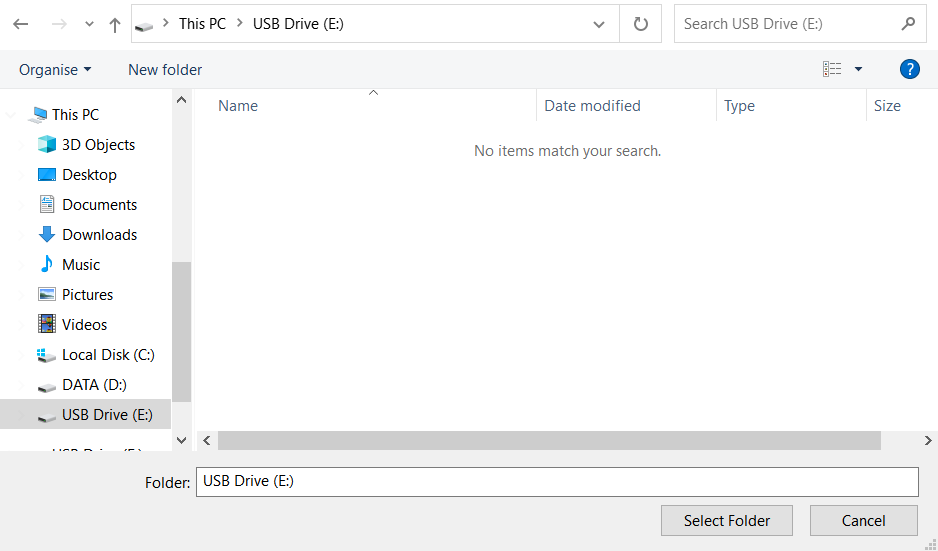
Then, you need to specify the file formats. This option is located at the bottom, too. As it was mentioned, PhotoRec can recover the files of about 400 different formats.
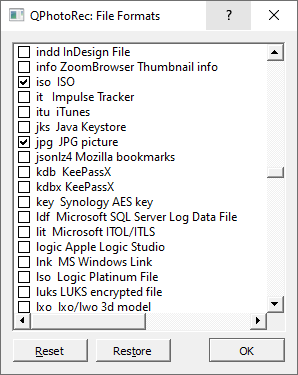
Finally, you can start files recovery by pressing the “Search” button. You will see the screen where the results of the scan and recovery are shown.
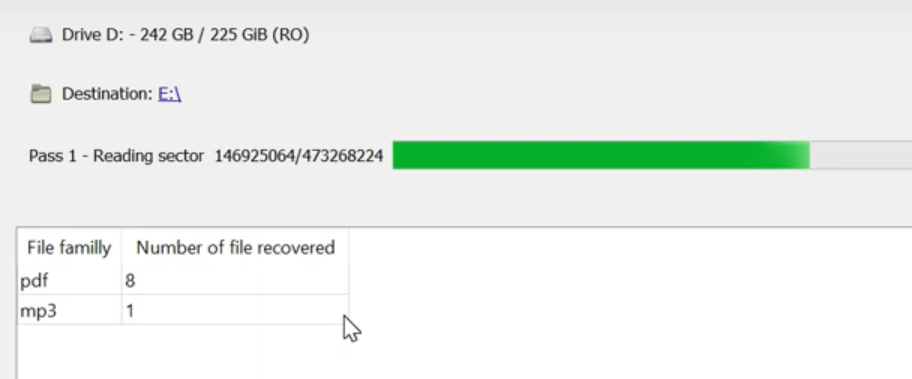
Agvv files recovery guide
Frequently Asked Questions
Agvv virus is a type of malicious software that infects a victim’s computer, encrypts their files, and demands a ransom payment in exchange for the decryption key.
It is often distributed through torrents and other illegal software downloads. It can also be spread via malicious email attachments, fake software updates, or exploit kits.
Decrypting files without paying the ransom is typically challenging. However, there are some limited options available, such as relying on data backups or searching for third-party decryption tools online. It is recommended to consult with cybersecurity professionals for guidance.
In this situation, you need to prepare the memory stick with a pre-installed Trojan Killer.
Have patience. You are infected with the new version of STOP/DJVU ransomware, and decryption keys have not yet been released. Follow the news on our website.
We will keep you posted on when new Agvv keys or new decryption programs appear.
The Agvv ransomware encrypts only the first 150KB of files. So MP3 files are rather large, some media players (Winamp for example) may be able to play the files, but – the first 3-5 seconds (the encrypted portion) will be missing.
You can try to find a copy of an original file that was encrypted:
- Files you downloaded from the Internet that were encrypted and you can download again to get the original.
- Pictures that you shared with family and friends that they can just send back to you.
- Photos that you uploaded on social media or cloud services like Carbonite, OneDrive, iDrive, Google Drive, etc)
- Attachments in emails you sent or received and saved.
- Files on an older computer, flash drive, external drive, camera memory card, or iPhone where you transferred data to the infected computer.
I need your help to share this article.
It is your turn to help other people. I have written this guide to help people like you. You can use buttons below to share this on your favorite social media Facebook, Twitter, or Reddit.Please leave a comment here! This can help other victims to understand they are not alone. And together we will find ways to deal with this issue.
Brendan SmithAGVV Ransomware — How To Restore & Decrypt Files?
Name: AGVV Virus
Description: The AAGV virus, also known as the AGVV Ransomware, is a type of malicious software that belongs to the STOP/Djvu ransomware family. This harmful virus is designed to infiltrate and compromise computer systems, specifically targeting files of various formats, such as documents, photos, and videos. Once infected, the AAGV virus encrypts the files, making them inaccessible to the users unless a ransom is paid. It appends a unique ".agvv" extension to the encrypted files, allowing for easy identification. This virus can cause significant damage by restricting access to important files and demanding payment for their decryption. It is crucial to maintain strong cybersecurity measures to prevent infection and mitigate the risks associated with the AAGV virus.
Operating System: Windows
Application Category: Virus
User Review
( votes)References
- You can find a sample of AGVV Virus Ransomware on VirusTotal.com
- My files are encrypted by ransomware, what should I do now?
- About DJVU (STOP) Ransomware.
- GridinSoft Anti-Malware Review from HowToFix site: https://howtofix.guide/gridinsoft-anti-malware/
- Trojan Killer Review: https://howtofix.guide/trojan-killer/
![]() German
German ![]() Japanese
Japanese ![]() Spanish
Spanish ![]() Portuguese (Brazil)
Portuguese (Brazil) ![]() French
French ![]() Turkish
Turkish ![]() Chinese (Traditional)
Chinese (Traditional) ![]() Korean
Korean ![]() Indonesian
Indonesian ![]() Hindi
Hindi ![]() Italian
Italian


